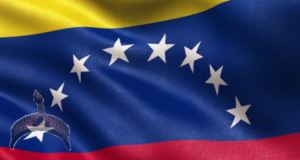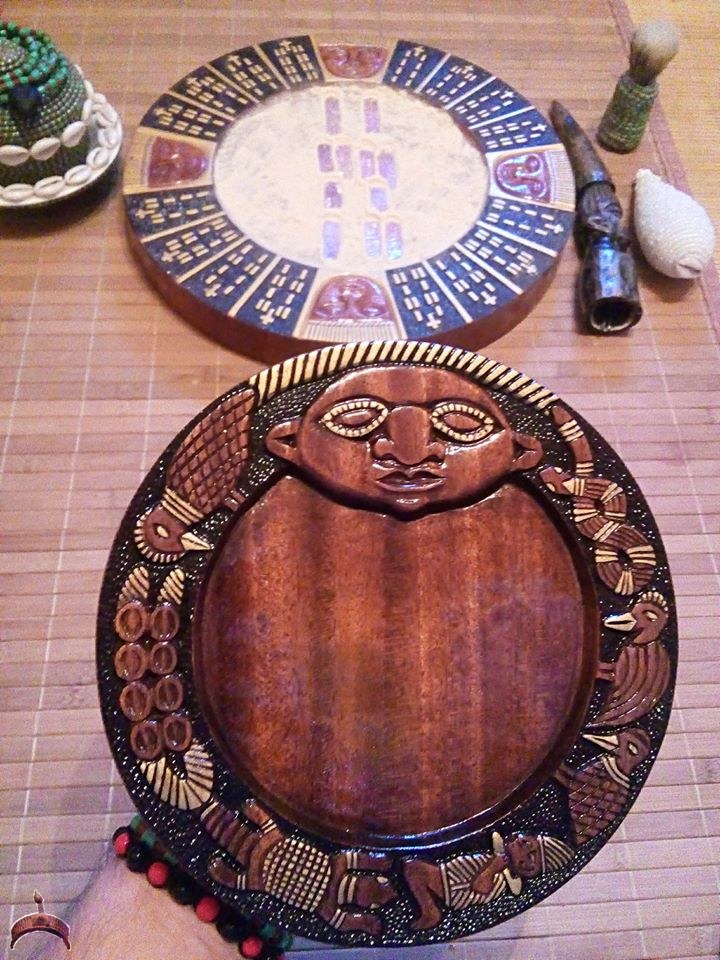An early 20th Century Opon Ifá divination tray, from the collection of the Brooklyn Museum An Opon Ifá (known as La Mesa de Ifá in Latin America) is a divination tray used in traditional African and Afro-American religions , notably in Ifá and Yoruba tradition . A Babalawo (diviner) uses the Opon Ifá in order to communicate with the spirits who are able to identify the causes and solutions to personal and collective problems and restore harmony with the spirits.
Opon Ifás are flat and usually circular, between about 6 and 18 inches in diameter, with a raised outer edge carved with figures, objects, or geometric designs.Opon Ifás may also be rectangular, semi-circular, or an approximate square.The top of the tray is called the head, and the bottom, the foot – the latter is typically placed closest to the diviner. At the head is generally carved with a representation of Eshu, the messenger of Ifá and the other spirits.
Certain trays may have additional representations of Eshu, and trays with two, four, eight, and even sixteen faces have been seen.In cases such as this the head of the tray may be marked by cowries .The cowries are also used to spread the sacred divining powder. Rectangular Opon Ifá tray On the Opon Ifá, the Babalawo throws sixteen palm or kola nuts onto the flat wooden surface, and determines which eight of the 256 possible sets of Odus (signs) are displayed. The signs have correlating verses which must be chanted, and chosen according to the client’s particular situation. In many traditions, a divination chain known as Opele has replaced the palm or kola nuts, which are reserved for more serious questions.
An early 20th
Century Opon Ifá
divination tray, from
the collection of the
Brooklyn Museum
An Opon Ifá (known as La Mesa de Ifá in
Latin America) is a divination tray used in
traditional African and Afro-American
religions , notably in Ifá and Yoruba
tradition .
A Babalawo (diviner) uses the Opon Ifá in
order to communicate with the spirits who
are able to identify the causes and
solutions to personal and collective
problems and restore harmony with the
spirits.Opon Ifás are flat and usually
circular, between about 6 and 18 inches in
diameter, with a raised outer edge carved
with figures, objects, or geometric
designs.Opon Ifás may also be
rectangular, semi-circular, or an
approximate square.The top of the tray
is called the head, and the bottom, the foot
– the latter is typically placed closest to
the diviner. At the head is generally carved
with a representation of Eshu, the
messenger of Ifá and the other spirits. Certain trays may have additional
representations of Eshu, and trays with
two, four, eight, and even sixteen faces
have been seen.In cases such as this
the head of the tray may be marked by
cowries .The cowries are also used to
spread the sacred divining powder. Rectangular Opon Ifá
tray
On the Opon Ifá, the Babalawo throws
sixteen palm or kola nuts onto the flat
wooden surface, and determines which
eight of the 256 possible sets of Odus
(signs) are displayed. The signs have
correlating verses which must be chanted,
and chosen according to the client’s
particular situation. In many
traditions, a divination chain known as
Opele has replaced the palm or kola nuts,
which are reserved for more serious
questions.
Oluwo Olokun Fayemiwo
 Ọmọ Oòduà Naija Gist | News From Nigeria | Entertainment gist Nigeria|Networking|News.. Visit for Nigeria breaking news , Nigerian Movies , Naija music , Jobs In Nigeria , Naija News , Nollywood, Gist and more
Ọmọ Oòduà Naija Gist | News From Nigeria | Entertainment gist Nigeria|Networking|News.. Visit for Nigeria breaking news , Nigerian Movies , Naija music , Jobs In Nigeria , Naija News , Nollywood, Gist and more









